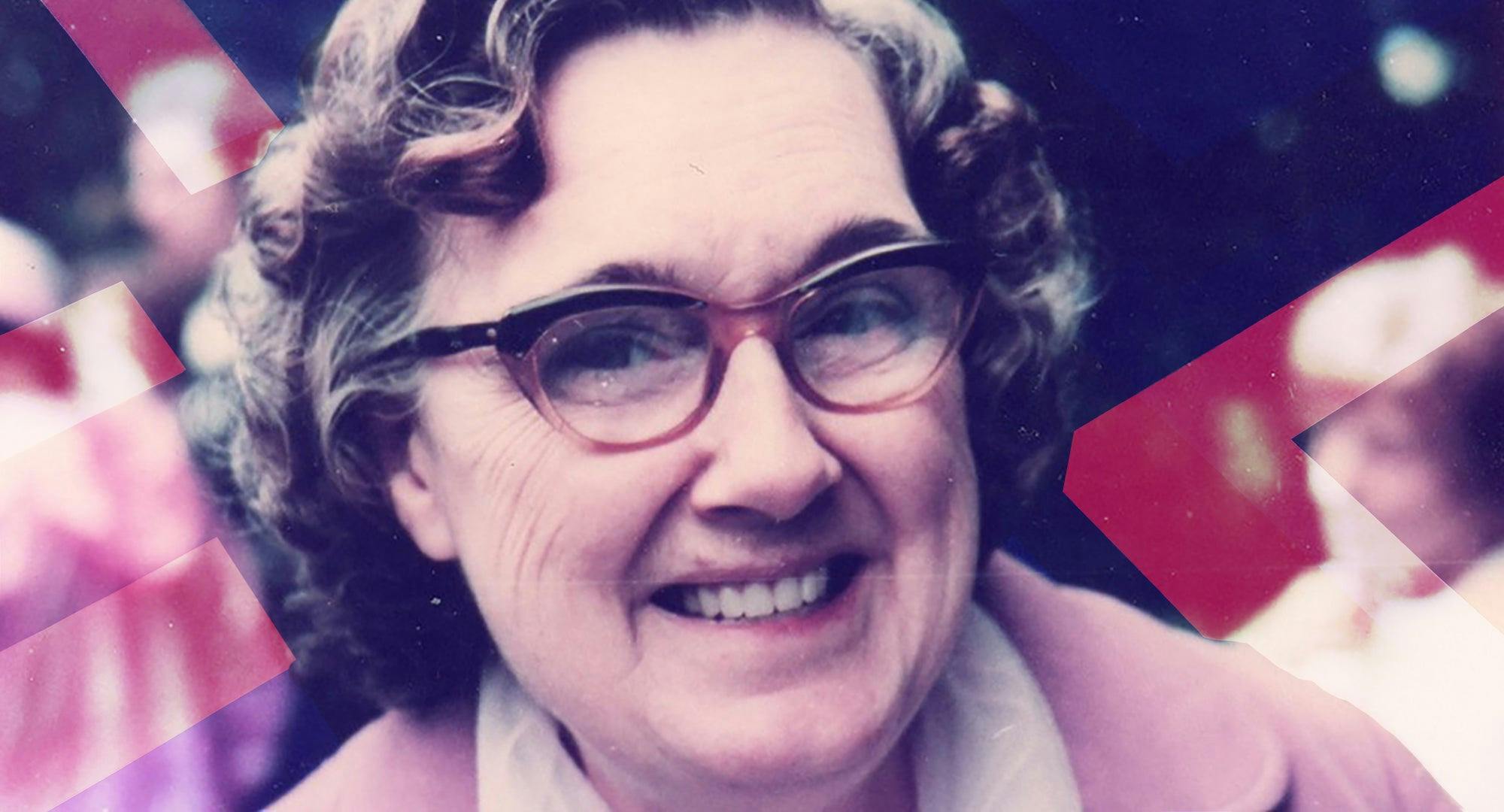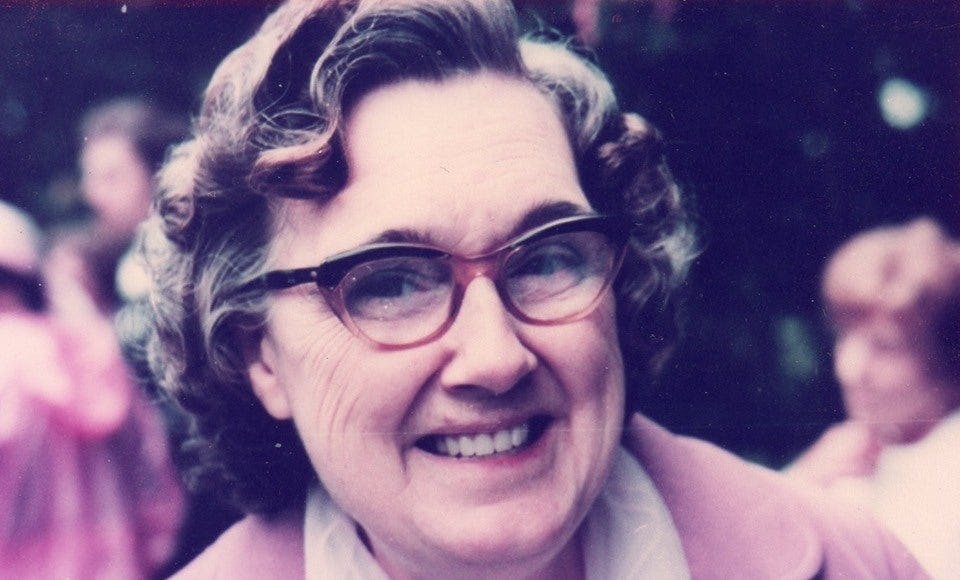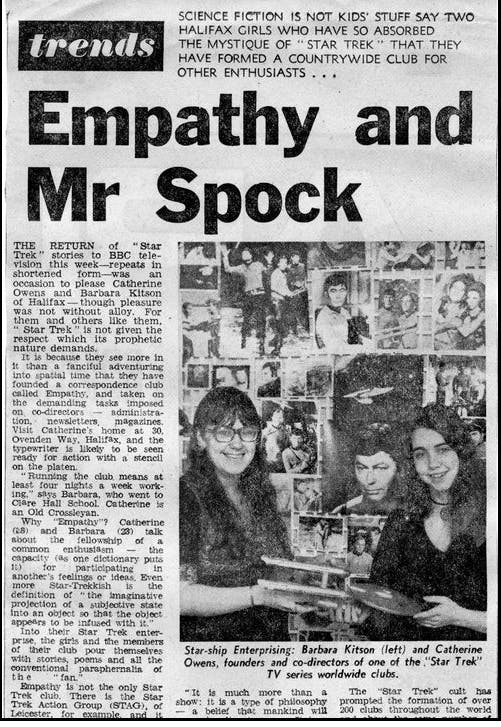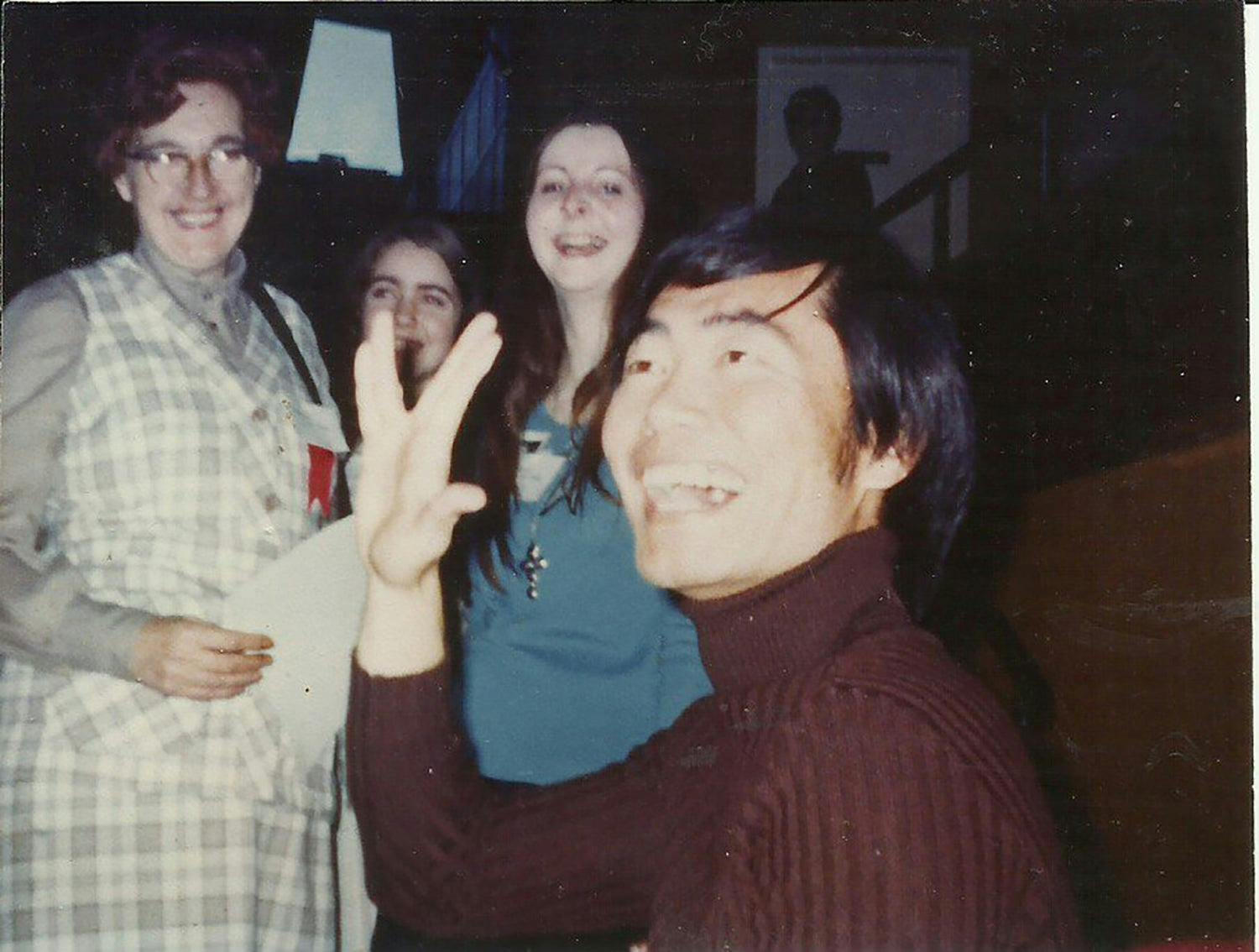Published Sep 8, 2021
How Dorothy Owens Brought Star Trek to the UK
Memories of the Empathy Star Trek Club and TerraCon give us insight into this amazing superfan's life.

Rachel Perkins
In almost all the ways, Dorothy "Dot" Owens broke the traditions for what society stereotyped as a “nerd." She was a mother to five daughters and a grandmother, who lived in a small house in Yorkshire, England, with her husband Joe, and her German Shepherd, Sheba. She wore her hair short and in curls, picked out pastel patterns to wear, and worked in retail — sometimes surviving paycheck to paycheck.
This otherwise typical woman just also happened to be the chairperson for a number of UK-based Star Trek fanzines as well as an organizer of several Star Trek conventions across England in the 1970s and ‘80s. Her events drew in international Star Trek stars such as George Takei and D.C. Fontana, as well as other familiar names in the Science Fiction circles, such as Hugo-award winner Anne McCaffrey, and The Hitchhiker’s Guide to the Galaxy writer Douglas Adams.
Dorothy was also my Nan, and right up until her death in 1984, she continued to be a big part of the Star Trek community in Britain.

Rachel Perkins
She became involved in the fandom through the passion of her daughter (and my mother), Catherine, had for the series. In October 1974, at the age of seventeen, Catherine started the Empathy Star Trek Club with Barbara Kitson, who herself was only twenty two. At the end of their first year, they had already attracted press attention and were featured in their local newspaper, The Halifax Courier, which described Dot as being, “converted to the cult”.
Empathy was by no means the only UK Star Trek club around at the time; instead, it was part of a much bigger collection of community hubs, which included the Star Trek Action Group (commonly referred to as STAG), Omicron, Beyond Antares, Star Trek Correspondence Club, DeForest Kelly Appreciation Society, and many more. But, given that Star Trek was being shown nationally on BBC1 at the time, and there were also talks of a movie featuring the original cast, many fans and clubs were deeply connected.
Yet, for my family, what started as a small semi-regular fanzine was about to become something a lot bigger.
The club began publishing new magazines such as Emanon, Contact, Tricorder, and Empathy News, the goal of which was to bring fans together. Poems, short stories, sketches, and articles were published in these periodicals— a celebration of passion and creativity that the excitement of new Trek movies and the original episodes brought. 80 pence bought an annual subscription of the regular publications, which would cover the cost of printing, with an additional 40p for special anthologies, which ran alongside. Individual issues would range anywhere between fifty to one hundred pages.
Running the magazines soon became a bigger venture. In the family home, there was a collection of stamps from subscribers, and the storage upstairs was filled with boxes of paper awaiting printing. Their first typewriter was a portable Smith Corona, used to make the stencils for the magazine. While the entire house was a base of operations for the club, the kitchen was where printing took place as it housed the stencil duplicator (also known as the mimeograph machine). Initially a manually operated Roneo brand, it was later upgraded to a Gestetner, before going electric in the 1980s. The kitchen was chosen because printing would last long into the night and the following morning. That way the noise didn’t disturb others’ sleep.
When Catherine moved to London in 1975, she briefly stayed as president of the club, but then Dorothy took over the operation and organization.

StarTrek.com
Around the same time, the Star Trek convention scene was just getting started. A fellow club, STAG, organized the first two “official” British Star Trek conventions, which set the stage for Star Trek gatherings on a much broader scale. Starting with a group of around 70 in a church basement, their conventions quickly grew, and moved to the Abbey Motor Hotel for its inaugural year as The British Star Trek Convention. Both “official” conventions were intimate events, focused on community and camaraderie which the classic series seemed to kindle. What STAG put together with their Star Trek conventions in the UK set the stage for future conventions to take place with an already established audience.
However, in 1975, following the second convention, the president of STAG (then Jenny Elson) was forced to step down due to health reasons. Her sudden departure left a void for clubs who wanted to continue the annual get-togethers. While not an experienced event planner, Dot was a working mother to five daughters and a grandmother to a growing number. Multi-tasking was second nature to her. Combined with her classic Yorkshire endurance and a passion for community, she had a working formula.
The first convention that she organized was TerraCon, often referred to as “the third British Star Trek convention”, which was held on October 9th and October 10th of 1976 at the Dragonara Hotel in Leeds. Originally reserved for 250 attendees, space filled up so quickly they were forced to make additional reservations at the nearby Queens Hotel. In the end, approximately 400 Star Trek fans descended for the weekend that scheduled a cosplay competition packed with Klingons and Romulans, an art show, a group quiz, a disco, signings, auctions, and a cinema.
Star Trek was at the heart of the convention, but filming obligations made inviting Trek stars a challenge. Instead, the convention attracted guests such as Mat Irvine, a visual effects designer for the BBC, whose credits included Blake’s 7 and (later) Doctor Who, and Nick Tate, who was starring in the British sci-fi series Space 1999 as Alan Carter. Tate would later go on to play a number of characters in Star Trek, including Liam Bilby in the Deep Space Nine episode “Honor Among Thieves,” as well as Dirgo in The Next Generation episode “Final Mission.”
Reportedly, creating the event took 16 hour days, spread across many months. The marathon of work concluded with a celebratory buffet table for the committee and stewards, put together by Dot in the closing hours.
Community was always at the heart of these events, whether it was writing and creating an anthology of fan work, or organizing conventions. It was never about personal gain, and whatever profit there was went to charity organizations such as Cancer Research UK. £308.25 was donated from the first convention alone (£2,150 in today’s currency). Special guests who attended the conventions had their travel and accommodation paid for in addition to their attendance fee. Many, if not all, the guests waived their fees, instead wanting it to also be donated to the same charity.
After the first TerraCon, some changes were made. Instead of Leeds, the convention moved west to Liverpool. It took place at the Liverpool Centre Hotel on September 10 and 11th, 1977. Flying over guests proved once again to be tricky, but George Takei signed up as the guest of honor. BBC’s Mat Irvine also returned for the second year, along with Hugo and Nebula Award winner, author Anne McCaffrey, who would become a regular guest.
By the second convention, TerraCon had started to attract the attention of the local and national newspapers, including the Daily Express who headlined an article “Trekkers Beaming For Show” the day ahead of the convention. The piece closed with a quote from Dot explaining her passion for Trek in a rare interview: “It’s basically about peace. If 400 people on a starship can live peacefully then there’s hope for the rest of the world.”

StarTrek.com
The second year proved to be more challenging than the first. Dot had a number of helpers, dubbed “Dot’s Angels,” who assisted with preparation. Those duties would range from making sure that the guests were met at the airport and escorted to the Liverpool Centre Hotel, to helping to prepare attendee packs ahead of official start. One of the convention stewards, Susan Gamble, remembers the “buzz” of the last-minute organizing rush. She told StarTrek.com, “[At] one of the cons, there was quite a little production area going in Dot's room. I was making Tribbles, others were compiling zines (using the dreaded duplicator and then spreading themselves out on the floor to put the pages together), [and] there was fancy dress making.”
After its second event, Dot and TerraCon took a short break, instead creating two smaller events: the Empathy Midi-Con in 1978, and the STAG and Empathy Star Trek Midi-Con in 1979, organized in cooperation with STAG. While much smaller than other events, both conventions were considered “official” community gatherings, and featured special treats for attendees of the Empathy Midi-Con, including a message sent by Gene Roddenberry to STAG. In his fifteen-minute message, Roddenberry talked about the progress on Star Trek: The Motion Picture: "Everyone seems to agree that Captain Kirk's entry onto the bridge of the Enterprise, after being absent for all of those years? When those elevator doors open and he stands there and the camera goes in on his face... it is a real gripping moment. Anyone who's been in love with [a] vessel and a certain way of life will understand totally what it means to him." Likewise, the STAG event a year later started with a special half-an-hour recording with Susan Sackett, Roddenberry’s assistant, who had been previously approached to appear as a guest.
In October 1979, TerraCon returned to a rainy Leeds with special guests Rupert Evens, a former stuntman and also adviser on Star Trek: The Motion Picture, as well as notable names in the science-fiction circles, such as writer Douglas Adams and television model-maker Philip Rae. Again, the program included talks by the guests, group showings of beloved episodes, auctions, competitions and more. The cosplay competition, referred in the program as a “galactic fashion show,” drew much interest and following the event, STAG posted a wanted ad in their December newsletter asking "Wanted: Any photos of the Dancing Tribbles in the fashion show at TerraCon."
Once again, profits from the event went to charity, with the exception of raffle tickets. Keeping in tradition of community, the money for the raffle went to help purchase an electric wheelchair for a fellow fan. The prizes included four tickets to a press showing of Star Trek: The Motion Picture.
After five “official” conventions and several smaller local gatherings, Dot announced that she would retire from organizing after TerraCon 1980. For the last adventure, the con returned to the Dragonara Hotel in Leeds, with special guest D.C. Fontana, who stayed at Dot’s house during her visit to the UK. As well as taking part in community events and talks throughout the weekend, Fontana also made a surprise appearance in cosplay at the fashion show, which she helped to judge.
The event was a success, and ended with a closing ceremony that was described in a follow up report in the Beyond Antares newsletter as “charged with emotion.” It went on to state, “those members who have never been to a convention, or who don’t know Dot, may wonder why she was given such a huge send off… Dot contributed greatly to the British fandom by arranging five excellent conventions – three in Leeds, one in Liverpool, and one in Manchester, plus many small gatherings for fans”.
But Dot’s retirement was short-lived. While TerraCon never returned, and other “official” British conventions took its place, she did return to event organizing with another committee member, Keith Jackson, for a final two conventions dubbed EmpathicCon.
The first event was held in Liverpool in April 1983 and was originally planned to be a smaller and more intimate convention from the start. While the event had Star Trek at its heart, it also celebrated science fiction as a whole and featured guests Thom Christopher (from Buck Rogers in the 25th Century) and, once again, Anne McCaffrey. With her health declining, it was also to be Dot’s last event, although she would go on to make arrangements for a gathering the following year.
Dorothy Owens passed away from cancer in the late hours of February 1st 1984. Despite difficulties with her illness, she continued to work to arrange her final convention, EmpathicCon II. Upon her request, her collection of Star Trek magazines were donated to a convention auction further down the line, with the amount raised going to a nearby children’s hospital. The event continued in her memory, organized by the Empathy committee, stewards, and her family.
On the convention program’s first page, which was usually reserved for community creations reads simply a paraphrase of Irish poet, William Butler Yeats, “There are no strangers here - only friends you have yet to meet.” With these words dedicated to her memory, Dot’s spirit was ensured to live on
Connecting with Fans Aboard Star Trek: The Cruise
Based in London, Rachel Perkins (she/her) is a writer with a passion for Star Trek, video games, cats, and Nancy Drew. She can often be found writing for The Sudden Stop and Positively Tomb Raider. Find her on Twitter @JadenRachel.

